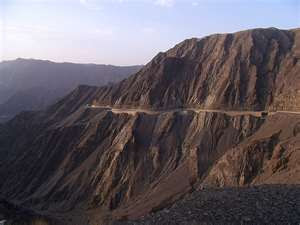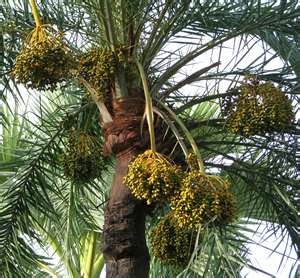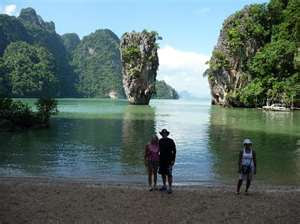The Arabian coastal plains are anywhere between five and forty miles inland. It rains a lot there and the air is very moist. They separate the inland plateaus from the seas that surround them.
These are two examples of coastal plains.
Adaptations:
One adaptation is that the coastal plains are very good for farming.
Another is that they can take the tree's sap for myrth and frankincense.
This is an example of a coastal plain that is good for farming. You can tell it has very rich fertile soil which is very important in farming.
This is an example of tree sap getting collected, which they did a lot in the Arabian coastal plains.
Total Pageviews
Thursday, March 31, 2011
Arabian Mountains
The mountains of the Arabian Peninsula is what separates the deserts and the coastal plains. The climate includes wind, rain, and frost in the winter. It is usually cool because of the elevation.
These are two pictures of the Arabian mountain ranges.
Adaptations:
One is, to help them farm they created irrigation systems.
Another one is that the mountains allowed to to grow fruit such as melon and pomegranate.
This is a picture of an irrigation system
This is a picture of a pomegranate that they would grow near the mountains.
These are two pictures of the Arabian mountain ranges.
Adaptations:
One is, to help them farm they created irrigation systems.
Another one is that the mountains allowed to to grow fruit such as melon and pomegranate.
This is a picture of an irrigation system
This is a picture of a pomegranate that they would grow near the mountains.
Arabian Deserts
Arabian deserts are hot and dry and sandy. Three fourths of the Arabian Peninsula is made up of deserts. The people who live in the deserts have animals that they hers and raise. They have to live off of what their animals can provide for them and they try to trade as much as they can.
This is a picture of the Arabian desert. It is very sandy.
This is a picture of a camel on the sand of the Arabian desert.
Adaptations:
One adaptation is that people use camels to travel around the desert so they don't have to walk the whole way.
Another one is that the people changed the clothes they where. They where vert loose clothes made of cotton because of the heat, and where headdresses to protect them from sandstorms.
This is a camel, which they use a lot in the Arabian desert.
This is an example of what they would wear.
This is a picture of the Arabian desert. It is very sandy.
This is a picture of a camel on the sand of the Arabian desert.
Adaptations:
One adaptation is that people use camels to travel around the desert so they don't have to walk the whole way.
Another one is that the people changed the clothes they where. They where vert loose clothes made of cotton because of the heat, and where headdresses to protect them from sandstorms.
This is a camel, which they use a lot in the Arabian desert.
This is an example of what they would wear.
Arabian Oasis
Arabian oases are fresh water places. They occur when water gets trapped underground. They provide shade and plant life. They grew dates, peaches, and grains. One very important thing they grew was the palm tree. They also dug wells there.
Adaptations:
One adaptation is that they grew date palm trees which is a good source of food and shade.
Another is that the nomads and their animals have water which is very hard to come by in the desert area.
These two pictures are examples of Arabian oases.
This is a picture of the date palm tree they would grow there.
This is an example of a nomad and his camel at an oasis for water.
Adaptations:
One adaptation is that they grew date palm trees which is a good source of food and shade.
Another is that the nomads and their animals have water which is very hard to come by in the desert area.
These two pictures are examples of Arabian oases.
This is a picture of the date palm tree they would grow there.
This is an example of a nomad and his camel at an oasis for water.
Sunday, March 20, 2011
India Article Summary- Indian Cuisine: Healthy and Delicious
Summary:
Indian food is very nutritious. Indian food uses vegetables in a way that makes them incorporated into the food so they taste good. Some common ones are brussels sprouts, cabbage, carrots, cauliflower, celery, cucumbers, corn, eggplant, green beans, orka, peas, peppers, potatoes, radishes, spinach, squash, and tomatoes. They also have many other healthy things such as beans, whole grains, and spices. Indian food is known for their spices. They are very good for you and prevent many diseases. One more thing that is very good for you that Indians do is that they use small amounts of meat in their diet. Many are vegetarians but even those who aren't eat very small amounts of meat. Indian food cooked at home is very healthy, but at many Indian restaurants, it is cooked in an unhealthy way.
How it relates to what we have been studying:
This article relates to what we have been studying because there were some presentations on Indian food. This expanded my learning about Indian food.
Wednesday, March 9, 2011
India Presentations Wrap-Up
4 Sentences of Summaries of Different People's Presentations:
1. The trade in India included many different things that were very important to India and helped them to grow as well as explore new ways to trade such as by ship which was used by people on the coast of India but before that the people of Northern India could trade more because of the countries that surrounded them.
2. There were many different religions in India, some more important than others but there were many important major beliefs such as the belief in reincarnation, karma, many gods, and the caste system; those all had to do with the religion of India which was very important.
3. The food of India is very unique for many reasons such as the many spices they used and there were also many different important things about the food such as the differences between ancient Indian food and modern Indian food, the origins of Indian food, and how the food changed during different time periods.
4. The Hindu Deities were very important to India especially the three main ones but there are many other important things about the deities such as who worshiped them, what they represent, and how they are worshiped.
1. The trade in India included many different things that were very important to India and helped them to grow as well as explore new ways to trade such as by ship which was used by people on the coast of India but before that the people of Northern India could trade more because of the countries that surrounded them.
2. There were many different religions in India, some more important than others but there were many important major beliefs such as the belief in reincarnation, karma, many gods, and the caste system; those all had to do with the religion of India which was very important.
3. The food of India is very unique for many reasons such as the many spices they used and there were also many different important things about the food such as the differences between ancient Indian food and modern Indian food, the origins of Indian food, and how the food changed during different time periods.
4. The Hindu Deities were very important to India especially the three main ones but there are many other important things about the deities such as who worshiped them, what they represent, and how they are worshiped.
Alyssa and Carly's Project on Ancient Indian Language and Literature
This is the link to the powerpoint https://docs.google.com/leaf?id=0B4uG3xUBWc4LOWY1ZjE5ZDItMmU3My00N2QyLWI2ZDYtNDRmYjcwMmRiODdm&hl=en
This is the script that goes with the powerpoint so it makes sense...
Slide 2
A: bhobho askaakam prakalpa asti upari bharatavarsiiya caanii uta saahitya.
C: hai avayo karyayo jana asti upa bharatavarsiiya bahaasika ca saahitya. That was 2 examples of a Sanskrit translation of daying, “Hello, our project is on Indian Language and Literatue.
Slide 3
A: There are many different dialects and word variations in Sanskrit.
C: Sanskrit is also not the only language Indians speak. There are others such as Prakrit, Pali, and Apabhramsa, but they all share similar sounds and words.
A: Not all languages spoken in India are written languages. They have methods of writing like the ancient method, Harappan. Harappan is picture writing, like Egyptian hyroglyphics. It was used to mark property and keep track of things such as trade.
C: Harrappan was used before 1500B.C. Once that year was reached, there were no records of writing for the next 1000 years.
A: It was like they had forgotten how to write, and then relearned in 500B.C.
C: That was the year that Sanskrit was invented.
A: Sanskrit is the language that the Vedas are written in, but the commentaried and explanations are in Upanishads.
Slide 4
C: The Vedas are sacred Indian pieces of literature.
Slide 5
C: They were written by monks, mostly in the form of song. Children are made to memorize them from a young age.
A: Unlike in America, reading is not for fun in India, it is usually for religion.
Slide 6:
Both: The end. Bye!
C: Or as they say in Sanskrit…
A: Arusa apasaaritaa. Vigama!
This is the script that goes with the powerpoint so it makes sense...
Slide 2
A: bhobho askaakam prakalpa asti upari bharatavarsiiya caanii uta saahitya.
C: hai avayo karyayo jana asti upa bharatavarsiiya bahaasika ca saahitya. That was 2 examples of a Sanskrit translation of daying, “Hello, our project is on Indian Language and Literatue.
Slide 3
A: There are many different dialects and word variations in Sanskrit.
C: Sanskrit is also not the only language Indians speak. There are others such as Prakrit, Pali, and Apabhramsa, but they all share similar sounds and words.
A: Not all languages spoken in India are written languages. They have methods of writing like the ancient method, Harappan. Harappan is picture writing, like Egyptian hyroglyphics. It was used to mark property and keep track of things such as trade.
C: Harrappan was used before 1500B.C. Once that year was reached, there were no records of writing for the next 1000 years.
A: It was like they had forgotten how to write, and then relearned in 500B.C.
C: That was the year that Sanskrit was invented.
A: Sanskrit is the language that the Vedas are written in, but the commentaried and explanations are in Upanishads.
Slide 4
C: The Vedas are sacred Indian pieces of literature.
Slide 5
C: They were written by monks, mostly in the form of song. Children are made to memorize them from a young age.
A: Unlike in America, reading is not for fun in India, it is usually for religion.
Slide 6:
Both: The end. Bye!
C: Or as they say in Sanskrit…
A: Arusa apasaaritaa. Vigama!
Subscribe to:
Posts (Atom)















